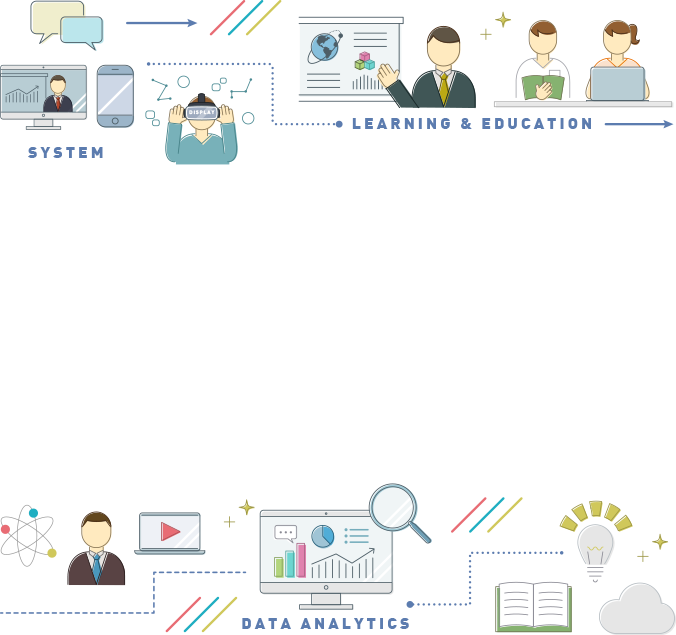Hello everyone, this is Geng Gakuwang, a 3rd year PhD student.
In this article, I would like to share with you the paper we read in this English literature seminar and my impressions about it.
Title :Effects of AR- and VR-based wearables in teaching English: The application of an ARCS model-based learning design to improve elementary school students’ learning motivation and performance
Journal:Journal of Computer Assisted Learning
Page number:1-18
Year of pubulication:2023
Author:Cheng-Yu Hung, Yen-Ting Lin, Shih-Jou Yu, Jerry Chih-Yuan Sun
Here is a summary of the paper.
Augmented reality (AR) and virtual reality (VR) provide authentic learning environments through immersion. In language learning, it has been reported that integrating new vocabulary into AR and VR-based learning environments has facilitated and motivated learners to learn vocabulary. In particular, compared to traditional text-based learning, AR and VR are superior in that they allow learners to apply their knowledge in a real-world environment, rather than merely passively participating in a class or memorizing knowledge. However, in the field of education, there is no research comparing the differences in learning motivation and learning outcomes between English teaching methods using AR and VR wearable systems and traditional English teaching methods. Therefore, this study investigated the effects of using AR/VR wearable systems and conventional English teaching methods on learning motivation and learning outcomes in English education.
For the study, 119 Taiwanese elementary school students were divided into three learning groups: a traditional English teaching method (control group), an AR group using an AR wearable system, and a VR group using a VR wearable system. The study was conducted in three sections in English classrooms.
Section 1: All three groups took a pre-test and the IMMS questionnaire (The Instructional Materials Motivation Scale; Keller, 2010), which measures learning motivation. The teacher then presented the English vocabulary using slides and picture cards to explain the learning content to the students; there were no statistically significant differences between the three groups in the four aspects of the ARCS model of English language learning and prior knowledge.
Section 2: Each of the three groups conducted a learning activity. Prior to the learning activity, students worked in small groups of five and received instruction on the operation and use of the learning system. Students in the control group read the textbook and used worksheets to learn the English names of stationery items; students in the AR group used the AR wearable system to scan stationery items in the real classroom environment and view virtual English word and meaning presentations to learn the names of those items in English. The students learned the name of the stationery in English by scanning it and viewing the virtual English word and meaning presentation. In contrast, in the VR group, students used the VR system to learn English words by clicking buttons on individual pieces of stationery in the virtual English classroom environment and reading the virtual information (English words and meanings) that appeared.
Section 3: First, all students reviewed the English vocabulary they had learned and practiced pronunciation. Then, a group activity was conducted. Students in the control group worked with their peers to find and fill in the missing alphabetic letters in the corresponding English words according to the pictures on the task cards; students in the AR group used an AR system to scan stationery to find the missing alphabetic letters in the English words with their peers; students in the VR group used a VR system to scan stationery to find the missing letters in the task cards with their peers. Students in the VR group used the VR system to find and fill in the missing letters on their task cards with their peers. All students then completed a post-test and the IMMS questionnaire. In addition, one student from each small group was selected to conduct a 15-minute semi-structured interview.
In order to motivate students to learn, English language teaching activities using AR and VR wearable systems were designed based on the ARCS model.
▪ Attention: When using the AR system, students need to move to the front of the classroom to focus on scanning stationery; the design of the virtual environment of the VR system draws students’ attention and helps them focus on the learning content.
▪ Relevance: The AR and VR systems combine knowledge of the English text with scenes from everyday life to create a highly relatable learning context, with stationery as the topic, which is commonly used in everyday life.
▪ Confidence: In the AR or VR environment, students can learn words they have not yet learned at their own pace and gain confidence through interaction with the system.
▪ Satisfaction: Students can gain satisfaction by achieving their learning goals in the AR or VR environment through their own effort and repetition.
The three groups’ responses to the posttest and the posttest IMMS questionnaire were analyzed by analysis of variance. Results showed that the three groups did not differ statistically significantly in posttest scores, attention, relevance, confidence, and satisfaction. In addition, multiple regression analysis was conducted to investigate how the four aspects of the ARCS model (attention, relevance, confidence, and satisfaction) affect learning outcomes in the three groups. Multiple regression analysis identified confidence as a significant positive predictor of learning outcomes in the VR group. This suggests that students in the VR group were able to effectively learn English vocabulary through real-time interaction with the system.
From the interviews and responses to open-ended questions, it was clear that the students in the VR group gradually learned vocabulary while helping each other solve problems. The increase in vocabulary proficiency also increased their confidence when tested, which significantly improved their learning outcomes. On the other hand, students who received traditional English instructional methods had difficulty changing learners’ long-term negative experiences in learning English due to the constraints of the traditional educational environment; students in the AR group experienced dizziness when using the AR system and were sometimes distracted by the AR system, so and that elements of the ARCS model were not predictive of learning outcomes.
I chose this paper because I am interested in how AR and VR technology can be used in foreign language education. In particular, I found the incorporation of elements of the ARCS model into the design of English language teaching activities that use AR and VR systems very helpful. On the other hand, I found something unexpected about the survey results. That is, there was no difference in learning outcomes and learning motivation between students who used the AR and VR systems and those who learned through textbooks.
However, prior studies I have read in the past that aimed to investigate learning motivation with an experimental approach reported that many AR and VR systems increase learning motivation more than text learning. Regarding the differences in these results, we were aware that the findings could be influenced by the novelty of the systems and the duration of the experiment. We are also concerned that the authors do not mention what advantages and disadvantages AR and VR systems have in language learning; a comparison of the advantages and disadvantages of AR and VR language learning systems would be more interesting and would deepen the discussion of the results.







